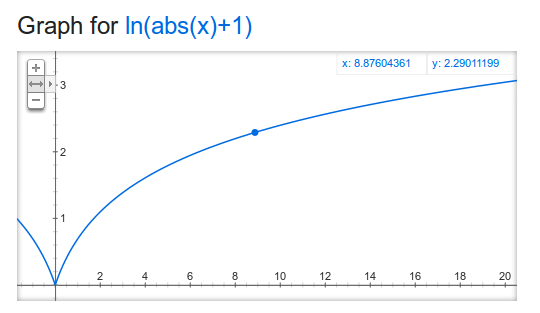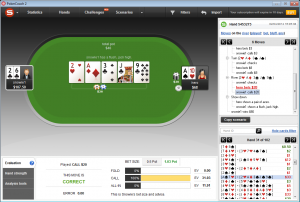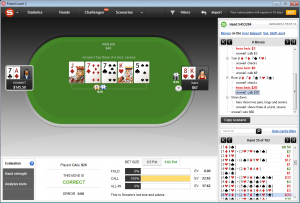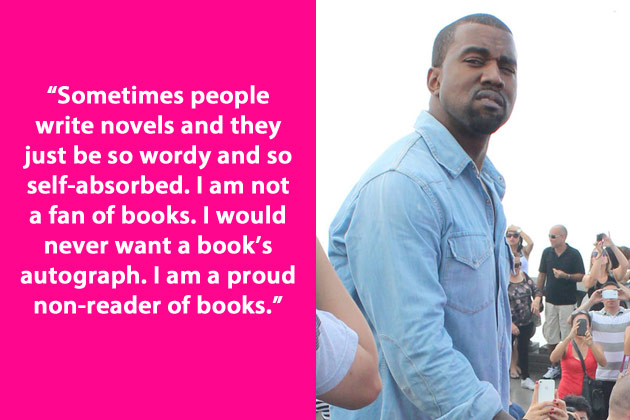I was planning on writing up a big post outlining every single formula you need to know for sports betting, but instead I made an open source website SportsBettingCalcs.com that does all the work for you. The javascript and little bit of python should be simple enough to follow and wikipedia and khan academy can do a much better job of explaining the formulas than I ever could. What a day we live in! So much free information out there. I left some relevant links at the bottom of the post if you’re interested in the formulas behind the site.
Let’s suppose you want to make a living sports betting. How many bets will you need to make to earn $100k per year? How large a bankroll do you need? How much should you bet? Which book should you bet with? If you can manage a 10% ROI (unlikely) you would only have to bet $1M/year ($100k / 0.10 = $1M). A more realistic goal is a 2-5% ROI which means you’ll need to wager between $2M to $5M. In order to bet $3M/year you need to make
-300 bets of $10k a piece or
-600 bets of $5k a piece or
-3000 bets of $1k a piece
There’s just no way you’re going to find 3000 +EV bets per year. That’s nearly 10 per day. So betting small in volume is not going to earn you much. Even if you gain a big edge in a small market like esports 300 bets of $100 a piece at 10% ROI would earn you $3,000. Yeah it’s decent, but the amount of work and effort required to achieve this would probably be better served working a plain old job with much less risk. Sports betting for most people is a hobby and should be treated as such by 99% of people.
Now you understand why there are so few people making a living betting sports. In order to make it full time you’ll need to bet a large amount(4 figures) on hundreds of games per year with a positive expectation. Obviously the amount you bet will not matter if you have no edge. Increasing your wager size will only increase the amount of money you will lose per bet if you have no edge. This is very important and obvious, but worth repeating. Knowing you have a winning strategy is your #1 priority before risking ANY amount of money wagering.
There’s very few people that have the bankroll, risk tolerance and skills to making living betting sports. If they do they’ll probably make more with less risk as a consultant or tout. Don’t expect to do this full time anytime soon. In order to make $100k/year you are going to have to risk something like 5% of your expected yearly earnings per bet. That’s incredibly risky. If you do manage to find a big edge in a sport, it’s unlikely you’ll be able to bet very large because the limits will be low. For the major sports, the limits are higher but potential edges are lower. For a sport like the NFL it’s easy to bet $10k+ per game before close but there’s only 256 games per year. There’s thousands of college basketball games per year, but limits are much lower. If your goal is to maximize $ earned I would recommend focusing on a sport that balances the amount of $ you can bet with the potential amount of edge you can gain. More realistically though your goal should be to maximize your enjoyment and minimize your losses with your likely losing hobby so I’d say focus on a sport you like and forget about everything else!
So say we’re shooting for a 3% ROI. A realistic goal. What kind of winrate do we need to have a 3% ROI? Using the ROI Calculator and typing in 1.9091 for odds (-110 is typical for a 50/50 wager) and 3% ROI and clicking calculate we get that we need to win about 54% of our bets. So we need to build a system that can go 54-46 on average for every 100 bets.
Let’s suppose we download a database of our sport of choosing, get all the historical closing lines and try to find an angle. Let’s say after much digging we find that on night games where there’s a full moon the home team covers the spread 40 times and loses to the spread 30 times. Great! Winning strategy, let’s bet it right?
Hold on a second. First, the angle has to make sense. You should be able to explain why the full moon favors the home team. Remember if you watch the roulette wheel long enough in the casino you may start to think you’re seeing winning patterns there too. Second, you need to be sure the results are significant. Is going 40-30 good enough to bet? Try typing it into the T-test calculator. This will perform a one sided t-test to see if the results are >52.38% (enough to cover the vig on a typical -110 odds bet). You will find that is less than one standard deviation away from the mean and not at all significant. What about a tout saying they are 12-5 or 100-70? Which is more significant? Type them in and find out for yourself 🙂
A more realistic example is say we find that betting large home underdog moneylines in MLB are underpriced.
Does this angle make sense? This makes intuitive sense because the public likes betting favorites so the bookies may shade their line towards underdogs. So say for example we think that betting home dogs of +170 are +EV.
What kind of winrate do we need? Using the Odds Converter and typing in +170 in the US Odds and clicking calculate we find that we only need to win 37% of the time or more to make a profit on these wagers.
Are our findings significant? In the past season let’s say we see that they actually went 127-173. Using the t-test calculator once again and using 127 for wins, 173 for losses and a population mean of 37% we find that the results are a winrate of 42% with a p-value of 0.03 which may be significant.
What’s our expected ROI? Using the odds converter we find that +170 equates to 2.7 decimal odds. Using the ROI calculator with 2.7 decimal odds, 42% winrate and solving for ROI we get an expected ROI of 13.4%.
How much should we bet? In general I’d say set aside a sports betting bankroll you are willing to lose and bet 1-2% of it per bet. Expected ROIs are just guesses. Just because an angle did well in the past does not mean it will do well in the future or at a bare minimum the ROI for the angle will not go down significantly. If you’d like to use the kelly criterion calculator I think 1/4 kelly is somewhat reasonable. So for our example, kelly multiple is 0.25, odds are 2.7, winrate is 42% and we get 1.97% recommended betsize.
Finally, let’s say after the first month of the season we’ve gone 18-42 getting an average of 2.7 odds on our bets. This is pretty bad, but is it bad enough to quit? Try out the Confidence Interval Calculator We expected to win 42% and need to win 37% to profit remember? 18-42 is a 30% winrate and the 95% confidence interval is 18.2% – 41.8%. So there’s still a decent chance we have a winning bet strategy, but it’s unlikely we are winning at the 42% chance we expected. It may be time to quit or re-evaluate or at bare minimum lower your betsize.
One last note… Always line shop at multiple books and always bet the larger number. For american odds +111 is better than +110. +101 is better than -101. -101 is better than -103. For decimal odds 2.101 is better than 2.09, 1.9 is better than 1.87. If you shop long enough you may even find two lines that when combined have negative vig on the Vig Free Calculator A few tips for when/if you do.
1. Make sure the book dealing the bad line will not scam you
2. Always bet the bad line before you hedge with the widely available line
3. Locking in the profit ie Hedging is -EV. In general you’ll make more just betting the rogue line but if you bet more than you’re comfortable with letting ride it’s a smart play to hedge
So I’ve been reading quite a lot about sports betting lately and I’ve learned a ton which I thought I’d share here. Before I get in to how to win at betting I think it’s important to examine a few other things first.
Is sports betting illegal?
Maybe. It depends where you live. A couple countries and states have explicitly outlawed it. I’d recommend talking to a lawyer or doing your own research if you want more clarity, but this Is sports betting legal in the United States article may provide some basic background. The one sentence summary is no actual bettors have ever been prosecuted, but plenty of bookies and payment processors have. It is very similar to poker in that regard.
What does a professional sports bettor do?
Make winning bets on sports obv. It’s a little more complicated than that though. Just like if you wanted to become a professional poker player you would be essentially saying “I think I can play in poker games where I make better betting decisions than the majority of my opponents” If you wanted to become a professional sports bettor you would essentially be saying “I think I can find and bet sports book lines that are improperly priced” Your job is to sniff out market inefficiencies and exploit them.
Who wins at sports betting?
So now that we’ve covered the legalities and job description let’s examine some people who make a living do this. First off, who have been some of the best?
Billy Walters
The story of Billy Walters is the story of how a lot of great fortunes have been made. He was in the right place at the right time and met the right people. He was pretty much a degenerate gambler who moved to Vegas at the right time and was hired by members of the infamous Computer Group of the 1980s to place bets for them. The Computer Group was one of the first groups to use computers to handicap sports and bet on inefficient lines. The group broke up around 1985 and Billy went out on his own and hired his own handicappers after that. You can see him on 60 minutes below.
Haralabos “Bob” Voulgaris
Bob was born in 1975. He was well aware of his predecessors like Billy Walters, but he started off making a living being a purely subjective bettor. He started betting NBA games in the late 1990s and made a fortune betting halftime totals back when bookies were dumb enough to set the halftime game totals at exactly 1/2 the game total(teams score more points in the second half down the stretch). In 1999 and 2000 he made huge all in bets for the Lakers to win the championship with his $80,000 bankroll . After that he had $1M to his name and went about hiring an ex-Wall Street quant to help him simulate and handicap NBA games. He has been quoted as having spent in excess of $3 million on his statistical NBA handicapping model.
Excellent interview write-up
2+2 Well
Blog
Twitter
His house and girlfriend at the time
In 2009-2010 he quit betting for awhile – nine months or so to pursue a job with an NBA team. This was his pretty hilarious response to someone who says they’ll never hire a gambler like him.
You couldn’t be more wrong. If I wanted to work for a team right now I could be working for a team. The problem isn’t finding a job, the problem is these jobs don’t pay anything.
GM salaries aren’t normally reported, but I know two assistant GMs who are making less than I pay 2 guys on my team, and I’d bet almost all but one or two GMs make less than my quant does.
A conference at which he was a featured guest. He’s on the far left.
Lots of other small time handicappers
There’s plenty of other less successful bettors out there. If you really wanted to make a career out of this most likely you will end up broke or like one of these guys. Betting sports for a living is incredibly difficult to do.
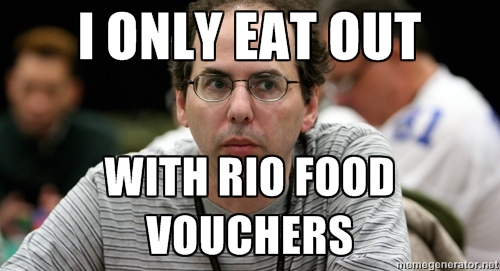
Bookies
Making a living as a bookie is way, way easier and they make way, way more money than the bettors. A sports bettor has to pick choose his spots very carefully and work very hard to find a 5% advantage. I bookie already has a 2-7% advantage on 99% of the bets they offer due to the vigorish How to be a successful bookie goes something like
1. Copy and paste lines off Pinnacle Sports
2. Pad the vig a bit to increase your bottom line
3. Optional: One minute before the line closes hedge any lopsided action at a larger book to decrease your risk
4. Profit
The problem of course is it’s probably illegal and you run the risk of going to jail.
Sports touts
Please don’t pay for picks. I’d say 99% are scams, but that’s probably an underestimate. Good handicappers don’t sell their picks. If you want to see some of these scammers at work check out CNBC’s show Money Talks The tout takes 50% of his clients’ winnings which makes it impossible for them to be long term winners. His clients need to win over 69% of their bets to break even. Even the best sports bettors in the world only win around 60%. He is making a good living off scamming – I mean sports betting though.
The one reputable sports tout I will mention is Right Angle Sports or RAS. They are proven winners who will charge something like $1,700 for a season’s worth of picks. Sounds great right? The problem with them is check out their Beating Line Movement page. Sports books subscribe to their picks too. Lines move within 5-30 seconds of when the pick is released. The only way you are going to make money using their picks is if you can bet a lot of money faster than anyone else who is also receiving their picks. I would not recommend trying.
There are plenty of handicappers who post their picks for free on twitter or public forums after they make them. If you find a winning one you’re welcome to tail them, but you’ll never get as good of a price on lines as them because the original handicapper’s bet will often move the line so even if he’s a proven winner his followers will have a lower ROI.
How to win at sports betting?
Winning at sports betting essentially boils down to
1. Find an inefficient betting line
2. Bet on the +EV side
3. Collect your winnings
Sounds simple right? Well there’s a lot more to it than that. In order to find an inefficient line you are going to need to know what the “correct” line is. In general, the smaller the book, the more likely it is that they
1. Have an inefficient line
2. Will scam you and not pay you your winnings
You will need to weigh the risks of these when betting with any small book. The ultimate tiny book is a “friendly” wager you might make with a buddy of yours. Maybe you ask your unwitting friend who knows nothing about sports betting if he wants to bet on the underdog at even money tonight? A step up from this might be your local bookie you met at the local casino or bar or whatever who will take your bets and doesn’t have good lines or updates them infrequently. You compare the lines he gives you to Pinnacle’s and bet when you find one that’s off by enough. A step up from that might be depositing on and trying to exploit one of the thousands of tiny illegal sports books online that don’t update their lines as quick as they should. A step up from that is trying to beat lines put out by the big boys like Pinnacle or Vegas Casinos. This is an order of magnitude more difficult, but the rewards are much greater and the risk much lower. There’s almost no chance of you being scammed out of your winnings and your max wager allowed will be much higher than any other books.
So if your plan is to try and beat the lines from one of the major books you’re going to need to start coming up with lines yourself. This is known as Handicapping and the biggest books are VERY good at it. Even when they make mistakes and put out bad opening lines, they are constantly adjusting the lines based on how much is bet on either side. An opening line will typically be different than a closing line. Even if you’re better at handicapping than the sportsbook, you need to figure out WHEN to place your bet. Depending on what data you are using to handicap, some models may be best suited for betting on opening lines and others may be best suited for betting closing lines when the game is about to start.
How to get an edge handicapping
There are many different ways to gain an edge vs the book. I’ll start with the least savory.
Fix Games
Unless you’re Marsellus Wallace or actually play a sport at a high level this option is not open to you and it’s obviously frowned upon – illegal? but it’s important to be aware that it does happen. It’s also the main reason bookmaking is largely illegal in the US. Major pro leagues like the NFL, MLB, NHL are terrified that if sports betting were legal it would ruin the integrity of the game and games would be fixed all the time. However, some people are changing their mind like the NBA’s ex-commissioner David Stern says it’s time for legalized sports gambling
The most infamous case of game fixing is probably the Black Sox Scandal of the 1919 World Series
Tim Donaghy was a high profile case of an NBA referee who bet on games and changed the spread on games by allegedly miscalling the end of games he officiated
As recently as today two lower ranked tennis players were suspended for match fixing
Insider Knowledge
Insider knowledge scares the crap out of sports books. It’s hard to obtain and if you have it there’s a decent chance you’re not allowed to bet on the games or don’t care about betting on games. I’m going to assume you’re not dating Tom Brady so we’ll largely skip over this edge.
Specialize
The main advantage a bettor has over the book is they don’t have to set lines for every game. They can pick and choose which games to focus on. I would recommend specializing in one particular niche where the competition is small. The downside to this is the max wager limits will be smaller, but there is more opportunity to find inefficient lines. The reason is the number of people handicapping, betting on and watching major league sports games like the NFL is orders of magnitudes larger than a less popular sport like golf.
Gather more data
This goes along with specializing. It’s going to be nearly impossible for you to gather more data than the sports books or other handicappors for a major game like the superbowl, but for a small game hardly anyone is going to be paying attention to like Mississippi Valley State vs Alabama State both members of the SWAC conference you may have a chance.
You may also find and use some data that no one else would think of using to handicap. Some hedge funds trade stocks based on your tweets New data is always being released. If you can find a source of data that predicts the outcomes of games that no one else is using you may have found yourself a nice edge.
Interpret the data better
There’s plenty of data out there, but people draw different conclusions based on the same data. Maybe you see something in the data that no one else does that will help you predict the outcome of a game. Maybe you write a better machine learning algorithm than anyone else. Maybe you adjust your model better than anyone else based on a major change in the game such as a lockout or a rule change. Week one of any sport is going to be difficult to predict because its a brand new team with different players and potentially different rules. There’s a big difference between predicting what kind of stats 30 year old veteran Lebron James will have in his 50th game of the season and a college freshman’s first collegiate game ever. A college freshman doesn’t have much to go by in terms of career stats and his play is likely going to improve drastically as time goes on. Maybe you figure out how to handicap young players play better than anyone else.
Use new data more quickly
It takes time for information to spread. If you can be one of the first to find out about something and bet based on that data before anyone else does you can gain an edge. Last season during the opening drive of a preseason game Sam Bradford tore his ACL If you were at the game and saw it happen or you were the team doctor(insider) who x-rayed him you could use that information to bet against the Rams in the upcoming games.
Intangibles or Subjective betting
Sometimes a player’s previous game data is a poor indicator of a player’s expected performance. After Brett Favre’s father died on a Sunday night he completely shredded the raiders on a Monday night game Look at the packers’ 2003 game by game passing stats Favre had by far his best game of the season and clearly had extra motivation to play well that day. Betting Green Bay to cover the spread was probably a good bet.
Take a look at what Steve Smith did when he played his former team the Carolina Panthers last season. He had two touchdowns and 139 yards. By far his best game of the season. Betting Baltimore to cover was probably a good bet.
In my next post I’ll go into the math and statistics involved with sports betting.
I took a look at Nate Silver’s March Madness Predictions and compared them with some online sports betting lines to see which were the best ROI bets according to his model. Below are the results. You can read a bit about how his model is created here: http://fivethirtyeight.com/features/march-madness-predictions-2015-methodology/
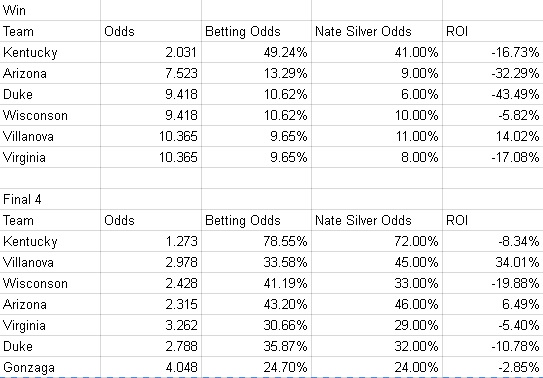
I’m certainly not advocating anyone bet on the games, but if you are going to Nate Silver has proven to be a fairly good handicapper. He thinks Villanova is pretty undervalued by the bettors in general especially their final 4 odds and Arizona is slightly undervalued to make it to the final 4.
Update: I took a look at the 1st round numbers too. The most interesting matchup is BYU vs Mississippi. The betting markets have Mississippi a 41% underdog, but Nate Silver’s model has them a 56% favorite.

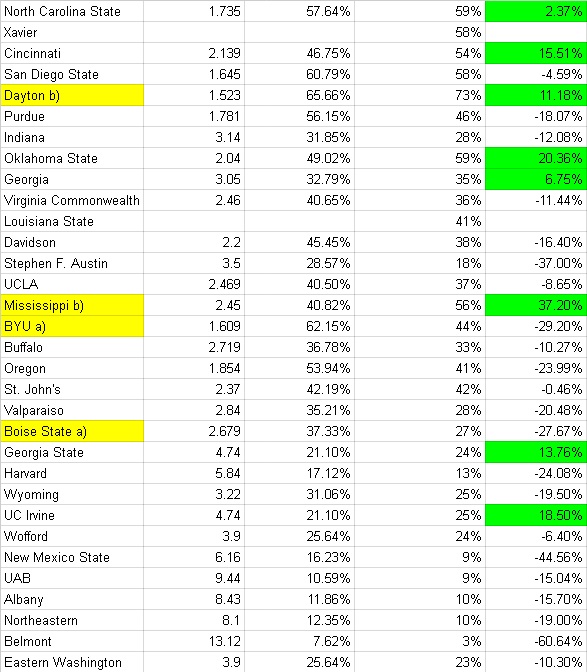
March 19 update: Wrote some code to automate these updates. You can view it here: https://github.com/andr3w321/march-madness-betting I’ll periodically update the data folder which shows the bets.
March 25 update: Model has yielded pretty terrible results. I’m not convinced Nate Silver would beat the spread.
In case you haven’t heard by now heads up limit hold’em has been solved. You can read the original scientific paper here
https://webdocs.cs.ualberta.ca/~bowling/papers/15science.pdf
You can query the GTO bot named Cepheus’ strategy here http://poker.srv.ualberta.ca/strategy
But it’s slow and not really displayed in an easy to understand way for humans emulate. It’s not easy to figure out if it tends to check back certain boards or what its cbet % is for example. I was curious if you could download the code and run it yourself and how much it would cost. The good news is you can download and run it yourself, the bad news it’s going to cost you a lot to get an exact Cepheus replica($500k by my estimate).
Cost of computing estimate
Looking at http://aws.amazon.com/ec2/pricing/
A large compute optimized on-demand instance with 32 2.6-GHz Intel Xeon cores, 60 GB of RAM, and 320-GB of local disk is probably the most similar node to the ones used by the Alberta researchers. They cost $1.68 per hour. To run 200 of them for 68.5 days would cost you 200*1.68*24*68.5=$552,384
Of course computing cost decreases over time over time as shown by the graph below. In a five years this computation cost should be one tenth of this current estimate and we’ll have 10TB hardrives for $50(current cost of 1TB hardrives http://www.amazon.com/Seagate-Desktop-3-5-Inch-Internal-ST1000DM003/dp/B005T3GRNW) and be able to download and save the whole strategy easily on our home computer.

Source: http://hblok.net/storage_data/storage_memory_prices-2013-02.png
Scientific Paper Interesting Stats
There were a few interesting stats given in the paper that I don’t feel were talked about much by the media because it wasn’t explained all that well and put in normal “poker speak” terms. They referred to a “hand” as a “game” and measured edges in “milli-big-blinds/game” instead of a more typical “bb/100”.
The maximum achievable winrate playing vs Cepheus is listed in the paper as 0.986 milli-big-blind per game(by game they mean hand). In poker terms this equates to (0.986 milli big blinds / hand) * (1 big blind / 1000 milli big blinds) * (100) = 0.986 * .1 = 0.0986 bb/100 maximum winrate. So for example if you were playing true GTO headsup $200/$400 limit holdem vs Cepheus you could expect to win about $200 * 0.0986 = $19.72 per hour per table.
Some major troll nits were complaining that if it’s possible to have a positive winrate vs Cepheus then heads up limit hold’em isn’t solved. What I would say to these people is
a) 0.1 bb/100 achievable winrate is tiny and
b) if they really want to get this number lower they can do so by simply turning their algorithm back on and letting it run more iterations.
It lists the button’s winrate vs itself as “between 87.7 and 89.7 mbb/g for the dealer” This means the GTO edge for the button vs the big blind is 88 * 0.1 = 8.8 bb/100. So in other words when someone hit and runs one hand with their button vs you they’re stealing 0.088bb or $17.6 at $200/$400 in EV from you.
Reducing computation cost
There are a number of ways you could create a much cheaper “good enough” GTO bot yourself. The way that they created Cepheus is by running this code http://webdocs.cs.ualberta.ca/~games/poker/software/CFR_plus.tar.bz2 on a 200 node cluster of computers for 68 days. It is described in the paper as
Our CFR+ implementation was executed on a cluster of 200 computation nodes each with 24 2.1-GHz AMD cores, 32GB of RAM, and a 1-TB local disk. We divided the game into 110,565 subgames (partitioned according to preflop betting, flop cards, and flop betting). The subgames were split among 199 worker nodes, with one parent node responsible for the initial portion of the game tree. The worker nodes performed their updates in parallel, passing values back to the parent node for it to perform its update, taking 61 minutes on average to complete one iteration. The computation was then run for 1579 iterations, taking 68.5 days, and using a total of 900 core-years of computation (43) and 10.9 TB of disk space, including filesystem overhead from the large number of files.
If you simply reduced the number of iterations ran you could create a not quite as good bot for a fraction of the cost. See the figure below from the scientific paper. Since they ran their sim for 900 core years or 1579 iterations they achieved a maximum exploitability of ~0.1 bb/100 (~$500k computation cost). Interpolating this graph that means that in 90 core-years of computation you could create a a bot with 1 bb/100 of exploitablity (~$50k computation cost). After 27 core-years computation cost you could create a bot with 10 bb/100 of exploitability (~$17k computation cost). After 9 core-years computation cost you could create a bot with 30 bb/100 of exploitability (~$5k computation cost).
You could further reduce computation cost by reducing the number of subgames. They solved for 110,565 subgames and their preflop strategy is very easy to view and download here http://poker.srv.ualberta.ca/preflop. You could hard code this in and reduce your computation cost drastically. Unfortunately at this time I haven’t worked out the math on how they arrive at 110,565 to calculate exactly what order of magnitude of computation this may save. If someone could help me out with that it would be greatly appreciated. There’s only 169 different preflop hand combinations, 1755 different flops each with 47 different turn cards and 46 different river cards.
Other games and online poker’s future
Their algorithm could easily be adapted to other limit games. Headsup limit Omaha 8 or better should be considered solved as well at this point. If someone wants to give me $1 million I’ll prove it. Same goes for headsup 2-7 triple draw. The stud games have a much higher number of game states so they may not be cheaply solvable at this point. Razz on the other hand ignores suits and only has 13 unique cards so a “good enough” headsup GTO bot (one with say 1bb/100 exploitability) could probably be created for $50k or less in computation cost at this point. It’s all a matter of time before all the games are dead and solved.
Some people will point out that the game state size of a no limit game is huge and may never be solved in our lifetime.
http://poker.cs.ualberta.ca/publications/2013-techreport-nl-size.pdf
Sure, it’s true that we may not see a Headsup No Limit Hold’em bot with maximum exploitability of less than 0.1bb/100 in our lifetime. That does not mean a “good enough” no limit bot with artificial pot size bet constraints (can only bet pot, 1/2 pot, 1/4 pot for instance) with less than 1 bb/100 of maximum exploitability could not be created TODAY for a couple hundred thousand.
It’s just a race to see who can figure it out first. The nosebleed guys hire programmers to figure out things out for them. They have the most money, resources and incentive to do so. It’s no secret at this point. I’m not optimistic about online poker’s future. Nobody plays online chess for money. Then again they do play online blackjack.
A more plain english summary of the paper is available here
http://spectrum.ieee.org/tech-talk/computing/software/computers-conquer-texas-holdem-poker-for-first-time
You can play against Cepheus here
http://poker-play.srv.ualberta.ca/
1. Manage my time better. This is my main goal and all other goals are really a subset of this goal.
2. Wake up and go to bed at regular times. I’ve been self employed for over six years now and waking up early and regularly is something I’ve struggled with as long as I can remember. Waking up late prevents me from having a very productive day and achieving my goals quicker than I otherwise would if I woke up early. Over the years I’ve learned a couple tricks to help me like practicing waking up, going to bed early the night before, and most of all doing it regularly since it takes about a week for your sleep schedule to adjust. Hopefully I can change that in 2014.
3. Read less 2+2/reddit. I’ve grown into a schedule of browsing the internet for an hour or two when I first wake up and right before I go to bed. Sometimes I read and learn interesting things, but usually I just end up reading random semi entertaining threads like If a player has a prosthetic arm that he used for holding onto the football and the arm got detached during the play, would that be considered a fumble or would the prosthetic limb still have possession for the player? In the morning it stops me from being productive, and in the evening it tends to keep me up later than I want to stay up and prevents me from being productive the next day. I don’t think I’ll ever kick the habit for good, but I’d like to decrease the amount of time I spend randomly browsing to focus on more productive or entertaining things.
4. Read more books. I’m somewhat embarrassed to say I only read 1.5 books last year. This is the least number I’ve read in a year since I was probably 12. I read American Sniper: The Autobiography of the Most Lethal Sniper in U.S. Military History and half of What Every BODY is Saying: An Ex-FBI Agent’s Guide to Speed-Reading People
Reading novels has been shown to boost brain function for days It increases your vocabulary and provides much deeper explanation on topics that you just can’t get from tweets and short internet articles which takes up the majority of young people’s reading sources these days. Plus at 1.5 books/year I’m getting dangerously close to becoming like Kanye West:
5. Exercise more. Pretty standard resolution here. Three times a week is what I’m shooting for. Maybe I will finally run that marathon this year I’ve been wanting to for awhile now, but we’ll see.
6. Blog at least once a month. I started tweeting a bit in 2013 and it kind of replaced my urge to blog, but there’s just some things you can’t get out in 140 characters. I don’t think 12 blogs per year is asking too much of my time.
7. Watch less TV. Spend more time reading books and working out instead.
8. Grow my businesses. Buy a house. These are pretty vague goals which are generally bad for goal making, but I’ll take these more on a month to month basis. In January I’d like to focus on BitcoinRichList.com and then on poker for Australia and the Aussie millions. In February I’d like to focus more on ATMs and condo buying.
Happy new year and best of luck to you all in 2014!
For a whole three seconds or so. 10:26-10:29. Totally worth the $10k. Pretty sure I’m famous now.

